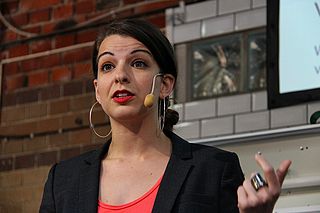
Sexual harassment is a type of harassment involving the use of explicit or implicit sexual overtones, including the unwelcome and inappropriate promises of rewards in exchange for sexual favors. Sexual harassment includes a range of actions from verbal transgressions to sexual abuse or assault. Harassment can occur in many different social settings such as the workplace, the home, school, or religious institutions. Harassers or victims may be of any sex or gender.
The bystander effect, or bystander apathy, is a social psychological theory that states that individuals are less likely to offer help to a victim in presence of other people. First proposed in 1964 after the murder of Kitty Genovese, much research, mostly in psychology research laboratories, has focused on increasingly varied factors, such as the number of bystanders, ambiguity, group cohesiveness, and diffusion of responsibility that reinforces mutual denial. If a single individual is asked to complete the task alone, the sense of responsibility will be strong, and there will be a positive response; however, if a group is required to complete the task together, each individual in the group will have a weak sense of responsibility, and will often shrink back in the face of difficulties or responsibilities. The theory was prompted by the murder of Kitty Genovese about which it was wrongly reported that 38 bystanders watched passively.

Bystander intervention is a type of training used in post-secondary education institutions to prevent sexual assault or rape, binge drinking and harassment and unwanted comments of racist, homophobic, or transphobic nature. A bystander is a person who is present at an event, party, or other setting who notices a problematic situation, such as a someone making sexual advances on a drunk person. The bystander then takes on personal responsibility and takes action to intervene, with the goal of preventing the situation from escalating.

Street harassment is a form of harassment, primarily sexual harassment that consists of unwanted sexualised comments, provocative gestures, honking, wolf-whistlings, indecent exposures, stalking, persistent sexual advances, and touching by strangers, in public areas such as streets, shopping malls and public transportation.

As sexual violence affects all parts of society, the responses that arise to combat it are comprehensive, taking place on the individual, administrative, legal, and social levels.

Amanda Ingrid Seales, formerly known by the stage name Amanda Diva, is an American comedian and actress. From 2017-2021, she starred in the HBO comedy series Insecure. In 2019, HBO released her first stand-up comedy special I Be Knowin. Then, in 2020, Seales launched Smart Funny & Black, a comedy gameshow that showcases Black culture, history, and experience. Seales was also one of the co-hosts of the syndicated daytime talk show, The Real
Cyberbullying or cyberharassment is a form of bullying or harassment using electronic means. Cyberbullying and cyberharassment are also known as online bullying. It has become increasingly common, especially among teenagers and adolescents, due to the communication technology advancements and young people's increased use of such technologies. Cyberbullying is when someone, typically a teenager, bullies or harasses others on the internet and other digital spaces, particularly on social media sites.

Steven Blake Crowder is an American-Canadian political commentator and media host.
Networked feminism is a phenomenon that can be described as the online mobilization and coordination of feminists in response to sexist, misogynistic, racist, and other discriminatory acts against minority groups. This phenomenon covers all possible definitions of what feminist movements may entail, as there have been multiple waves of feminist movements and there is no central authority to control what the term "feminism" claims to be. While one may hold a different opinion from another on the definition of "feminism", all those who believe in these movements and ideologies share the same goal of dismantling the current patriarchal social structure, where men hold primary power and higher social privileges above all others. Networked feminism is not spearheaded by one singular women's group. Rather, it is the manifestation of feminists' ability to leverage the internet to make traditionally unrepresented voices and viewpoints heard. Networked feminism occurs when social network sites such as Facebook, Twitter and Tumblr are used as a catalyst in the promotion of feminist equality and in response to sexism. Users of these social media websites promote the advancement of feminism using tools such as viral Facebook groups and hashtags. These tools are used to push gender equality and call attention to those promoting anything otherwise. Online feminist work is a new engine of contemporary feminism. With the possibility of connecting and communicating all around the world through the Internet, no other form of activism in history has brought together and empowered so many people to take action on a singular issue.

Sexism in video gaming is prejudiced behavior or discrimination based on sex or gender as experienced by people who play and create video games, primarily women. This may manifest as sexual harassment or in the way genders are represented in games, such as when characters are presented according to gender-related tropes and stereotypes.
Gamergate or GamerGate (GG) was a loosely organized misogynistic online harassment campaign and a right-wing backlash against feminism, diversity, and progressivism in video game culture. It was conducted using the hashtag "#Gamergate" primarily in 2014 and 2015. Beginning in August 2014, Gamergate targeted women in the video game industry, most notably feminist media critic Anita Sarkeesian and video game developers Zoë Quinn and Brianna Wu, among others. The harassment campaign included doxing, rape threats, and death threats. Gamergate proponents ("Gamergaters") stated that they were a social movement, but lacked well-defined goals, a coherent message, and leaders, making Gamergate difficult to define. Gamergaters claimed to promote ethics in video games journalism, claimed to be protecting the "gamer" identity, and opposed what they asserted as "political correctness" in video games.

2014 was described as a watershed year for women's rights, by newspapers such as The Guardian. It was described as a year in which women's voices acquired greater legitimacy and authority. Time magazine said 2014 "may have been the best year for women since the dawn of time". However, The Huffington Post called it "a bad year for women, but a good year for feminism". San Francisco writer Rebecca Solnit argued that it was "a year of feminist insurrection against male violence" and a "lurch forward" in the history of feminism, and The Guardian said the "globalisation of protest" at violence against women was "groundbreaking", and that social media had enabled a "new version of feminist solidarity".

10 Hours of Walking in NYC as a Woman is an October 2014 video created for Hollaback! by Rob Bliss Creative featuring 24-year-old actress Shoshana Roberts. The video shows Roberts walking through various neighborhoods of New York City, wearing jeans, a black crewneck T-shirt, with a hidden camera recording her from the front. The two-minute video includes selected footage from ten hours, showcasing what has been described as "catcalls" and street harassment of Roberts by men, reporting there were 108 such instances. The behaviors included people saying "hello" or "good morning", comments on Roberts' appearance, attempts to initiate conversation, angry remarks, and men following her for several minutes. As of September 2021, the video has received over 50 million views on YouTube.

The mass sexual assault of women in public has been documented in Egypt since 2005, when Egyptian security forces and their agents were accused of using it as a weapon against female protesters during a political demonstration in Tahrir Square, Cairo on 25 May. The behavior spread, and by 2012 sexual assault by crowds of young men was seen at protests and festivals in Egypt.
#MeToo is a social movement and awareness campaign against sexual abuse, sexual harassment, and rape culture, in which people publicize their experiences of sexual abuse or sexual harassment. The phrase "Me Too" was initially used in this context on social media in 2006, on Myspace, by sexual assault survivor and activist Tarana Burke. The hashtag #MeToo was used starting in 2017 as a way to draw attention to the magnitude of the problem.

Nadeen Ashraf is an Egyptian feminist activist. Her use of social media instigated the #MeToo movement within Egypt. She is part of the BBC's 100 Women of 2020 list.
Rumble is an online video platform, web hosting and cloud services business headquartered in Toronto, Ontario, with its U.S. headquarters in Longboat Key, Florida. It was founded in October 2013 by Chris Pavlovski, a Canadian technology entrepreneur.
Julie S. Lalonde is a Franco-Ontarian women's rights advocate, author, and educator. She has created multiple feminist organizations and education campaigns, and has offered many training sessions surrounding sexual violence, harassment, and bystander intervention. Her first book, Resilience is Futile: The Life and Death and Life of Julie S. Lalonde, was published in February 2020.
The #MeToo movement emerged in China shortly after it originated in the United States. In mainland China, online MeToo posts were slowed by government censorship. On Weibo, #Metoo and #MetooinChina were both blocked for a period of time. To avoid the censorship, Chinese women using the #MeToo hashtag on social media began using bunny and bowl-of-rice emojis; "rice bunny" is pronounced mi-tu in Chinese. Feminist activist Xiao Qiqi originated the use of rice-bunny emojis for the movement. nother alternative is “River Crab” which indicates censorship. Generally, the #Metoo movement was only accessible to elite women and urban women.
Mary P. Rowe is an Adjunct Professor of Negotiation and Conflict Management at the MIT Sloan School of Management, where she specializes in the areas of conflict resolution, negotiation and risk management.











